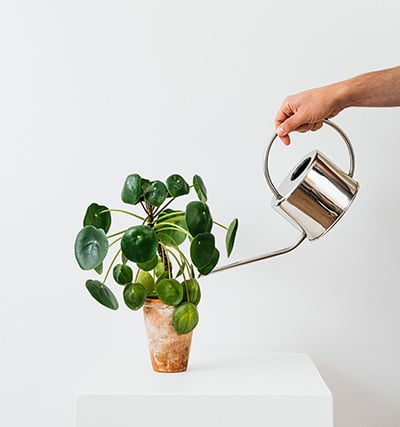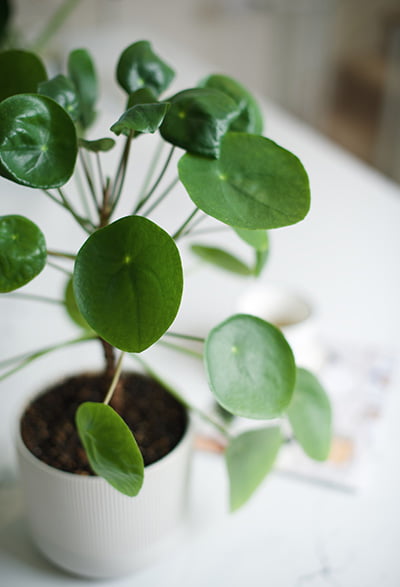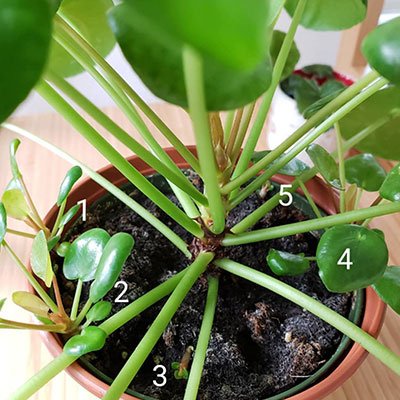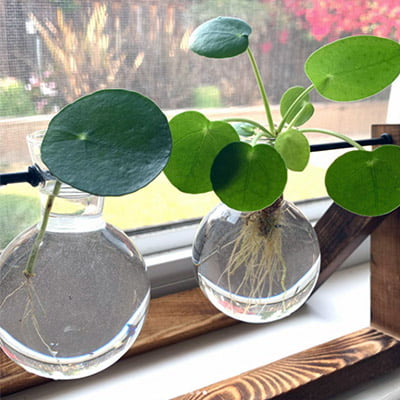Looking for a low-maintenance, beginner plant that brings wealth and good fortune into your space? Meet the Chinese Money Tree, also known as Pachira Aquatica. This tropical plant, native to Central and South America, is a popular indoor plant known for its braided trunk and five-lobed leaves that are believed to resemble the hand of Buddha.
In traditional feng shui practice, the Money Tree is believed to attract good luck, fortune, and prosperity into a space, making it a popular choice for homes, offices, and even businesses. Not only is the Chinese Money Tree aesthetically pleasing, but it is also low-maintenance and adaptable to different living conditions. Whether you're looking to spruce up your living space or add a touch of feng shui to your home, the Chinese Money Tree is a great option to consider.
To help your Chinese money plant thrive, we have put together this plant guide together. With a little attention and care, your Pilea Peperomioides will thrive and add a touch of green to your living space.
Botanical Name
Common Name
Plant Type
Mature Size
Sun Requirement
Soil Type
Humidity Level
Pet Friendly
Pilea peperomioides
Pass-it-on plant, pancake plant, lefse plant, UFO plant, friendship plant, missionary plant, or Pilea plant
Perennial
12 in tall, up to 12 in. wide
Bright, indirect
Well-draining
40% to 60%
Yes
What is a Chinese Money Plant
Chinese Money Plant is also known as Pilea Peperomioides, pass-it-on plant, pancake plant, lefse plant, UFO plant, friendship plant, missionary plant, or Pilea plant. This gorgeous plant has gained immense popularity recently due to its distinctive appearance and easy-to-care-for nature. The Chinese Money Plant has coin-shaped leaves that grow on a long, thin stem. The leaves have a smooth, shiny texture and are often described as looking like little UFOs!
The Chinese Money Plant has its roots in China and a fascinating backstory, as it was introduced to Europe by a Norwegian missionary back in the 1940s. Since then, it has made its way across the globe and is now a beloved plant in many homes and offices worldwide. With its quirky appearance and low-maintenance needs, it's no wonder the Chinese Money Plant has become a favorite among plant enthusiasts.
Chinese Money Plant Care Requirements
Light
Proper lighting is crucial to the well-being of your Chinese Money Plants. This plant prefers indirect, bright light, so placing them near a window that doesn't get direct sun is best. While they can tolerate lower light conditions, they may grow slower or produce fewer leaves. However, excessive direct sunlight may result in burnt or parched leaves.
Water
When watering your Chinese Money Plant, it's best to let the top layer of soil dry out before watering again. Finding a balance between overwatering and underwatering is crucial. Too much water can lead to root rot, while too little can cause the leaves to wilt and droop.

Source: Pexels
Temperature
Ideally, the Chinese Money Plant should be kept in a room that is between 65°F and 80°F (18°C-26°C) and away from any direct heat sources such as radiators or heating vents. This plant can be sensitive to cold drafts or sudden temperature changes, so it's best to avoid placing it in areas with fluctuating temperatures.
Humidity
The Chinese Money Plant is a beautiful and unique plant that requires a certain humidity level to thrive. Native to the rainforests of southern China, this tropical plant loves high humidity levels, making it a perfect choice for a bathroom or a kitchen.
If you notice the plant leaves edges are turning brown or crispy, this may be caused by low humidity levels. To keep your Chinese Money Plant healthy and happy, it's important to maintain a humidity level of at least 50%.
There are many ways to increase humidity around the plant. This includes placing a tray of water near the plant, adding a humidifier to your space, misting the plant, or placing your plant in the bathroom.
Soil
To create the perfect soil blend for your Chinese Money Plant, mix equal parts of potting soil, perlite, and peat moss. This will provide a light and airy texture that allows for optimal drainage while also retaining the moisture the plant needs.
If you are to purchase soil, look for ones that are suitable for houseplants or garden plants. It's important to avoid using heavy or compacted soil, as this can lead to root rot and other problems. Additionally, it's recommended to fertilize the plant every two weeks during the growing season to provide it with the necessary nutrients.

Source: Unsplash
Fertilization
Fertilizing your Chinese Money Plant is essential to its care routine and can help it grow strong and healthy.
To provide your plant with the necessary nutrients, it's recommended to fertilize it every two weeks during the growing season, which typically runs from early spring to late summer. You can use a balanced, water-soluble fertilizer to provide a mix of essential nutrients, including nitrogen, phosphorus, and potassium.
Be careful not to over-fertilize your Chinese Money Plant, as this can cause damage to the roots and leaves. Always follow the instructions on the fertilizer packaging and avoid fertilizing during the dormant season, as the plant does not require as many nutrients.
Propagation
With a little patience and some basic care, you can easily propagate your Chinese Money Plant and expand your plant collection. The ideal time for propagating is during spring and summer, when the plant is in its active growth phase. One of the best parts of this plant is how fast it produces baby plants and how you can propagate them into multiple plants. Here's a step-by-step guide to help you expand your plant family with the Chinese Money Plant.
From Suckers

Step 1: Locate the baby plant, known as the sucker, next to the mother plant. They grow out of the base of the plant, usually near the soil.
Step 2: Using a clean, sharp pair of scissors or pruning shears, carefully cut the sucker away from the main plant, making sure to leave a small portion of the stem attached.
Step 3: Fill a small pot with fresh potting and moist soil, and create a hole in the center.
Step 4: Place the cut end of the sucker into the hole, making sure it's buried deep enough to stand upright on its own.
Step 5: After watering the soil thoroughly, place the pot in a well-lit area with indirect sunlight. Over the next few weeks, monitor your new plant for signs of growth.
Step 6: Once your new plant has grown to a decent size, you can either keep it in its own pot or transfer it to a larger pot to allow it to grow even bigger.
Division
Step 1: Delicately extract the plant from its container and carefully separate the roots. You should be able to do this by carefully loosening the soil around the base of the plant.
Step 2: Once the roots are separated, gently pull apart the stems and leaves. Preserve as much of the root system intact as possible.
Step 3: If you have multiple stems, you can separate them into individual plants by gently pulling them apart. If you have only one stem, you can carefully cut it into several smaller sections with a sharp, clean knife.
Step 4: Once you have separated the plant, pot each section in a separate container filled with fresh potting soil. Thoroughly water each plant and position them in a spot with bright, indirect sunlight. Observe the new plants for indications of growth.
Step 5: When your new plants have grown a few inches tall and have a few healthy leaves, you can begin caring for them like any other Chinese Money Plant. Make sure to water them regularly, but not too frequently, and provide them with plenty of bright, indirect light.
Leaf Cutting

Step 1: Find a healthy, mature Chinese Money Plant to propagate. Look for a plant with several large, healthy leaves.
Step 2: Using a clean, sharp pair of scissors or pruning shears, carefully cut off one of the leaves at its base, making sure to leave a small stem intact.
Step 3: Once you have your leaf cutting, place it in a glass of water until it develops its own root system. Make sure that the stem is fully submerged and that the bottom of the leaf is just above the waterline.
Step 4: Place the glass in a warm, bright location without direct sunlight. Be sure to change the water frequently to prevent bacteria buildup and ensure the cutting has access to fresh water. After several weeks, you can expect to observe the emergence of roots from the base of the stem. Once the roots have grown a few inches in length, it indicates that your new plant is prepared for transplantation!
Common Problems
Yellowing leaves
If your Chinese Money Plant leaves are turning yellow, it might imply excessive watering. To resolve this issue, ensure that you permit the soil to dry out between waterings and modify your watering routine accordingly.
Wilting leaves
If your Chinese Money Plant has wilting leaves, it can be a sign of underwatering, so make sure you're giving your plant enough water. You can also try hydrating your plant by increasing humidity.
Brown spots on leaves
Brown spots on leaves can be a sign of sunburn, so make sure your plant is not getting too much direct sunlight. Move it to a shadier location if necessary.
Pests
Chinese Money Plants are susceptible to spider mites, mealybugs, and other pests. Keep a close eye on your plant and treat any infestations promptly with neem oil or insecticidal soap before it gets out of hand.
Root rot
Overwatering your plant can lead to root rot, and it can be fatal if it's not addressed. Make sure you're not letting the soil stay too damp for too long, and consider repotting your plant with fresh soil if necessary.
Stunted growth
If your Chinese Money Plant is growing slower than it should, it could be a sign of insufficient light. Make sure your plant is getting bright enough indirect light, or consider supplementing with artificial grow lights.
Is It Pet Friendly
Yes! Chinese Money Plant is pet friendly and can safely add to your indoor plants' collection.

